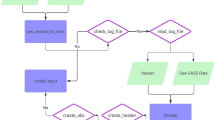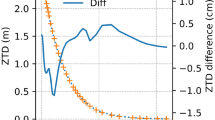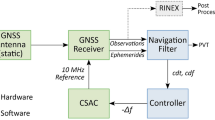Abstract
Precise point positioning with integer ambiguity resolution requires precise knowledge of satellite position, clock and phase bias corrections. In this paper, a method for the estimation of these parameters with a global network of reference stations is presented. The method processes uncombined and undifferenced measurements of an arbitrary number of frequencies such that the obtained satellite position, clock and bias corrections can be used for any type of differenced and/or combined measurements. We perform a clustering of reference stations. The clustering enables a common satellite visibility within each cluster and an efficient fixing of the double difference ambiguities within each cluster. Additionally, the double difference ambiguities between the reference stations of different clusters are fixed. We use an integer decorrelation for ambiguity fixing in dense global networks. The performance of the proposed method is analysed with both simulated Galileo measurements on E1 and E5a and real GPS measurements of the IGS network. We defined 16 clusters and obtained satellite position, clock and phase bias corrections with a precision of better than 2 cm.



















Similar content being viewed by others
Change history
06 July 2018
On pages 1, 2 and 11, “bernese GNSS software” should be replaced by “Bernese GNSS Software”.
References
Baarda W (1973) S-transformations and criterion matrices. Publ Geodesy 5(1):18
Blewitt G (1989) Carrier phase ambiguity resolution for the global positioning system applied to geodetic baselines up to 2000 km. J Geophys Res 94(B8):10187–10203
Brack A, Henkel P, Günther C (2014) Sequential best integer equivariant estimation for GNSS. Navigation 61(2):149–158
Brown RG, Hwang PYC (2012) Introduction to random signals and applied Kalman filtering, 4th edn. Wiley, New York
Bryson AE, Henrikson LJ (1968) Estimation using sampled data containing sequentially correlated noise. J Spacecr Rockets 5(6):662–665
Collins P (2008) Isolating and estimating undifferenced GPS integer ambiguities. In: Proceedings of ION NTM, ION, San Diego, CA, USA, pp 720–732
Collins P, Bisnath S, Lahaye F, Héroux P (2010) Undifferenced GPS ambiguity resolution using the decoupled clock model and ambiguity datum fixing. Navigation 57(2):123–135
Dach R, Hugentobler U, Fridez P, Meindl M (2007) Bernese GPS Software Version 5.0, User manual. Astronomical Institute, University of Bern, Switzerland
Dong D, Bock Y (1989) Global positioning system network analysis with phase ambiguity resolution applied to crustal deformation studies in California. J Geophys Res 94:3949–3966
Dow JM, Neilan RE, Rizos C (2009) The international GNSS service in a changing landscape of global navigation satellite systems. J Geodesy 83(3):191–198
Elsobeiey M, Al-Harbi S (2016) Performance of real-time precise point positioning using IGS real-time service. GPS Solut 20(3):565–571
Gabor M, Nerem R (2002) Satellite–satellite single-difference phase bias calibration as applied to ambiguity resolution. Navigation 49(4):223–242
Ge M, Gendt G, Rothacher M, Shi C, Liu J (2008) Resolution of GPS carrier-phase ambiguities in precise point positioning (PPP) with daily observations. J Geodesy 82:389–399
Geng J, Bock YD (2013) Triple-frequency GPS precise point positioning with rapid ambiguity resolution. J Geodesy 87:449–460
Hauschild A, Montenbruck O (2009) Kalman-filter-based GPS clock estimation for near real-time positioning. GPS Solut 13:173–182
Henkel P, Günther C (2010) Partial integer decorrelation: optimum trade-off between variance reduction and bias amplification. J Geodesy 84(1):51–63
Henkel P, Mittmann U, Iafrancesco M (2016) Real-time kinematic positioning with GPS and GLONASS. In: Proceedings of 24th European signal processing conference (EUSIPCO), IEEE, Budapest, Hungary, pp 1–5
Kouba J, Héroux P (2001) GPS precise point positioning using IGS orbit products. GPS Solut 5:12–28
Laurichesse D, Mercier F (2007) Integer ambiguity resolution on undifferenced GPS phase measurements and its application to PPP. In: Proceedings of 20th ION GNSS, ION, Fort Worth, TX, USA, pp 839–848
Laurichesse D, Mercier F, Berthias JP, Broca P, Cerri L (2009) Integer Ambiguity resolution on undifferenced GPS phase measurements and its application to PPP and Satellite precise orbit determination. Navigation 56(2):135–149
Laurichesse D, Mercier F, Berthias JP (2010) Real-time PPP with undifferenced integer ambiguity resolution, experimental results. In: Proceedings of 23rd ION GNSS, ION, Portland, Oregon, USA, pp 2534–2544
Lindlohr W, Wells D (1985) GPS design using undifferenced carrier beat phase observations. Manuscr Geod 10:255–295
Montenbruck O, Steigenberger P, Prange L, Deng Z, Zhao Q, Perosanz F, Romero I, Noll C, Stürze A, Weber G, Schmid R, MacLeod K, Schaer S (2016) The multi-GNSS experiment (MGEX) of the international GNSS service (IGS)—achievements, prospects and challenges. Adv Space Res 59(7):1671–1697
Odijk D, Zhang B, Khodabandeh A, Odolinski R, Teunissen P (2016) On the estimability of parameters in undifferenced, uncombined GNSS network and PPP-RTK user models by means of S-system theory. J Geodesy 90:15–44
Seepersad G, Banville S, Collins P, Bisnath S, Lahaye F (2016) Integer satellite clock combination for precise point positioning with ambiguity resolution. In: Proceedings of 29th ION GNSS, ION, Portland, OR, USA, pp 2058–2068
Teunissen PJG (1995) The least-squares ambiguity decorrelation adjustment: a method for fast GPS ambiguity estimation. J Geodesy 70:65–82
Teunissen PJG (1998) Success probability of integer GPS ambiguity rounding and bootstrapping. J Geodesy 72:606–612
Wen Z, Henkel P, Günther C (2011) Reliable estimation of phase biases of GPS satellites with a local reference network. In: Proceedings of 53rd international IEEE symposium on ELMAR, IEEE, Zadar, Croatia, pp 321–324
Zumberge JF, Heflin MB, Jefferson DC, Watkins MM, Webb FH (1997) Precise point positioning for the efficient and robust analysis of GPS data from large networks. J Geophys Res 102:5005–5017
Acknowledgements
The authors would like to thank the International GNSS Service (IGS) [see Dow et al. (2009)] for providing the GNSS measurements and the orbital reference of this work.
Author information
Authors and Affiliations
Corresponding author
Rights and permissions
About this article
Cite this article
Henkel, P., Psychas, D., Günther, C. et al. Estimation of satellite position, clock and phase bias corrections. J Geod 92, 1199–1217 (2018). https://doi.org/10.1007/s00190-018-1146-y
Received:
Accepted:
Published:
Issue Date:
DOI: https://doi.org/10.1007/s00190-018-1146-y




